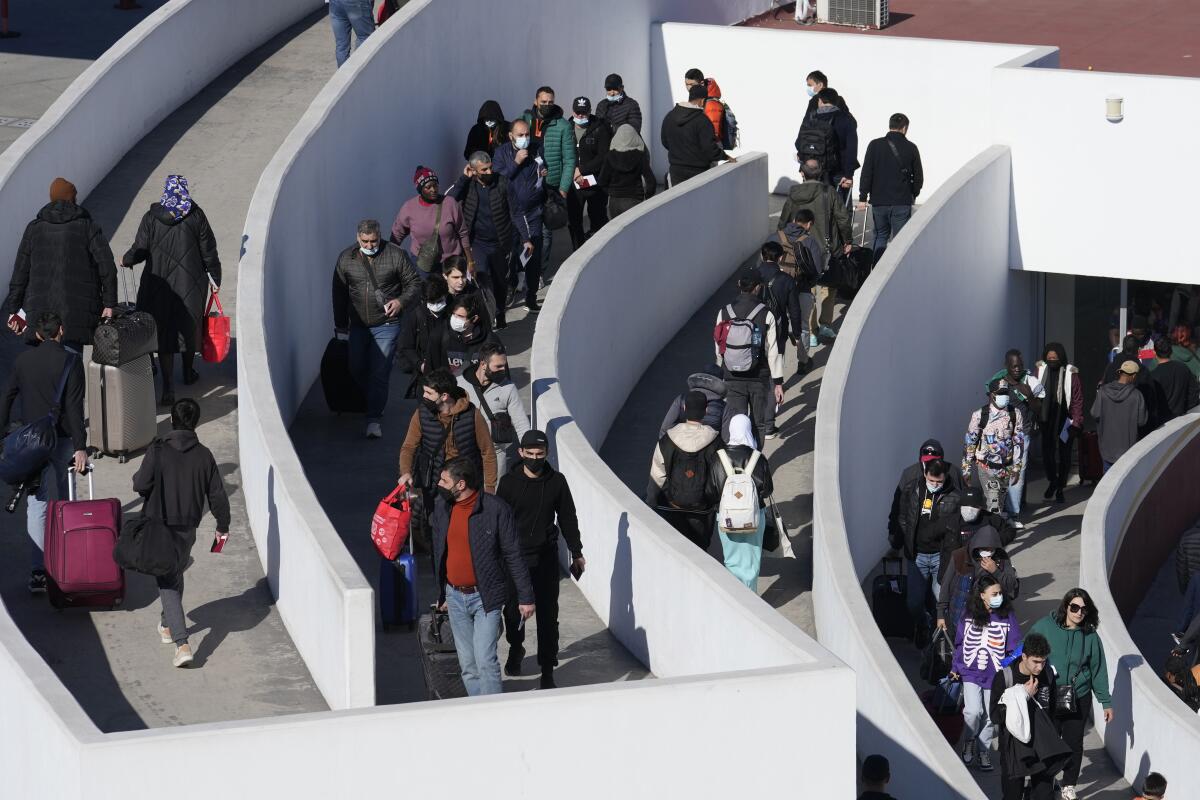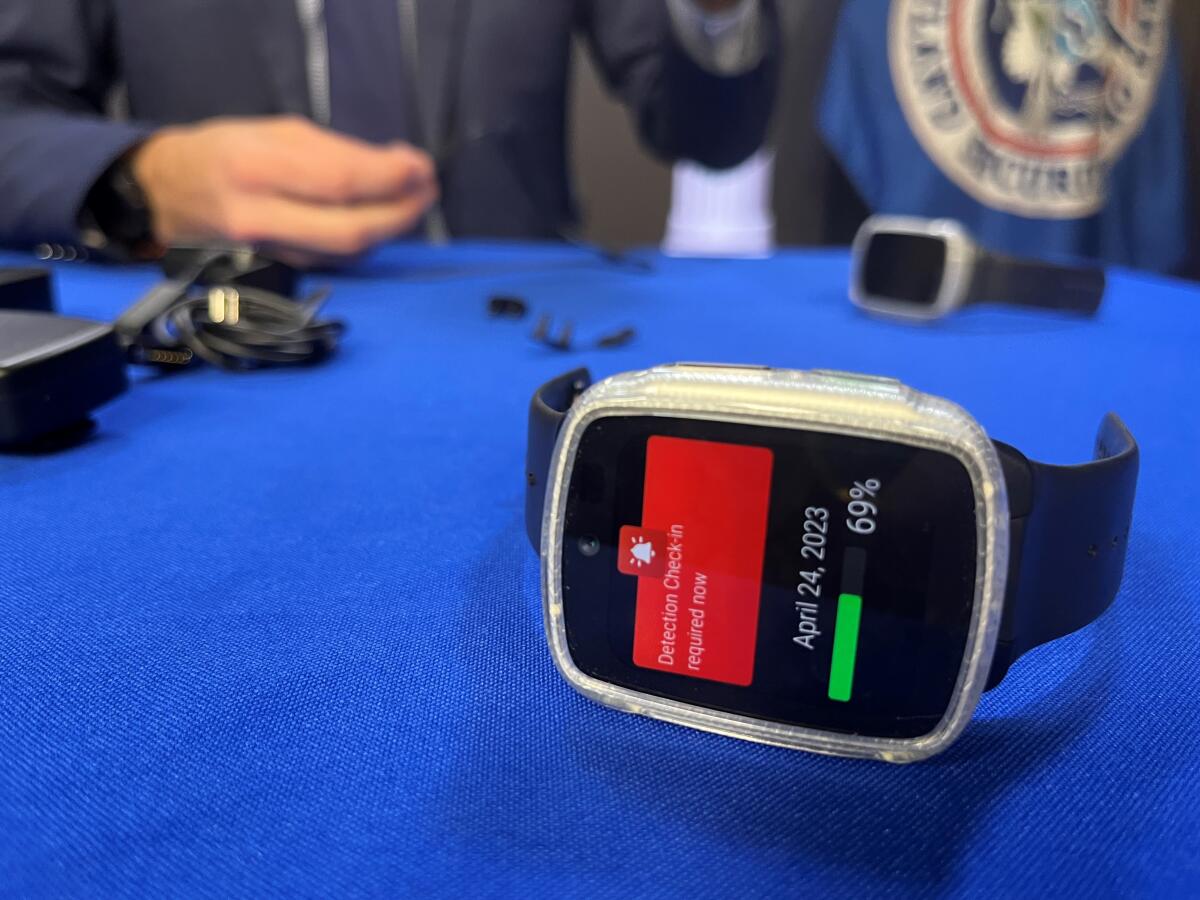U.S. to set up migrant centers in Guatemala, Colombia to curb border arrivals when Title 42 orders end

- Share via
WASHINGTON — The United States will establish regional processing centers for migrants in Colombia and Guatemala in an effort to reduce arrivals at the southern border after a pandemic-era policy ends next month, Biden administration officials announced Thursday.
The administration is also in talks with additional Latin American countries about the possibility of establishing more processing centers, said Homeland Security Secretary Alejandro N. Mayorkas.
Several thousand migrants will be screened at the centers each month for eligibility under the U.S. Refugee Admissions Program and other humanitarian and labor pathways. At a news conference with Mayorkas, Secretary of State Antony J. Blinken said he expects many more people to stay near the regional centers and wait for their chance to seek legal protections.
Blinken said Spain and Canada will accept referrals from the regional centers.
“Migration is the definition of a challenge that no country can solve alone,” he said.
The announcement comes two weeks ahead of the expected end of Title 42 orders, which were implemented amid the COVID-19 pandemic and prevented migrants from requesting asylum, allowing border agents to return many of them swiftly back to Mexico. Migrants have been expelled from the U.S. nearly 2.8 million times under Title 42 since March 2020.
When Title 42 orders are lifted May 11, immigration agents will return to processing people under the long-standing authority of Title 8. Deportations under Title 8 carry stiffer consequences, including potential criminal prosecution and a ban on reentry for at least five years.
The Department of Homeland Security will significantly expand the use of expedited removal to process migrants’ claims for relief and deport those who don’t qualify within days or a few weeks, Mayorkas said. Asylum officers and immigration judges are being sent to the border to speed up proceedings.
U.S. Customs and Border Protection has added phone booths and privacy booths to border facilities to aid attorney calls and asylum screenings, a practice first implemented by then-President Trump and suspended by President Biden. Migrants can be held in CBP custody for only three days and screenings currently take place within weeks after they leave.
Deportation flights will double or triple for certain countries, officials said. That includes flights to Cuba, which resumed this week after a pause since 2020. Homeland Security officials said the Cuban government agreed to not retaliate against deportees and that embassy officials in Havana are monitoring for compliance.
Mayorkas said the agency has expanded detention capacity for single adults and will use digital monitoring methods for other adults and families, including GPS ankle monitors, curfews and check-ins. This week, U.S. Immigration and Customs Enforcement officials said they said are piloting a new form of GPS monitoring — a wristwatch — that will be tested on 50 migrants in Denver for the next month before officials decide whether to expand its use. About 255,000 of the 5 million people in deportation proceedings are monitored through the agency’s Alternatives to Detention program.

The Department of Homeland Security has given $135 million to border communities for shelter, food and transportation of migrants this fiscal year and will award an additional $290 million in the coming weeks, officials said. The agency expects a rise in arrivals, with projections showing as many as 13,000 apprehensions of migrants per day after May 11.
Mexico will continue accepting up to 30,000 deported migrants after the use of Title 42 ends, Mayorkas said.
His department will also establish a family reunification program for people from El Salvador, Guatemala, Honduras and Colombia, Mayorkas said, as well as update existing reunification programs for people from Cuba and Haiti. Those programs allow people with family-based green card petitions to enter the U.S. under temporary humanitarian parole while they wait for those applications to be processed and immigrant visas to become available.
Officials said the migrant processing centers in Guatemala and Colombia will be run by “international partners” aided by U.S. personnel. Migrants will be able to make an appointment by phone to visit the nearest center before traveling.
Administration officials are working to finalize by May 11 a new rule that would make migrants ineligible for asylum if they enter the U.S. without permission and fail to apply for protection in another country on the way. Under the plan, some could still request asylum at an official port of entry but would largely be required to do so using CBP One, a phone application that migrants complain has been riddled with technical glitches and offers limited appointments that fill up within minutes.
Mayorkas said his department will expand available appointments through CBP One after the Title 42 policy expires.
“Let me be clear: Our border is not open and will not open after May 11,” he said.
Citizens of Venezuela, Haiti, Nicaragua and Cuba can apply for temporary lawful entry to the U.S. if they have a financial sponsor as long as they do not cross the Panama, Mexico or U.S. land borders without authorization. Mayorkas said Thursday that migrants from those countries who are interdicted at sea will become ineligible for the lawful entry program.
Federal officials say the measures offset record arrivals of migrants at the southern border, pointing to a 95% decline in encounters of people from those four countries between ports of entry. But 20 Republican-led states asked a federal judge to strike down the sponsorship program, arguing that the Department of Homeland Security exceeded its authority.
Immigrant advocates expressed support for the migrant processing centers and family reunification programs but criticized the fast-tracked asylum interviews, which they said would fuel wrongful deportations. Human Rights First has tracked more than 13,480 reports of violent attacks on migrants languishing in or expelled to Mexico, including killings, kidnappings and rapes, since Biden took office.
The International Refugee Assistance Project pointed to steep backlogs and long processing times for refugee admissions.
“Expanding family reunification parole pathways and refugee processing for displaced people in the Americas is long overdue, but we cannot ignore that the Biden administration is proposing a Faustian bargain by simultaneously seeking to implement a Trump-era asylum ban at the U.S-Mexico border, effectively slamming the door shut on countless others in need,” the project’s policy director Sunil Varghese said in a statement.
Homeland Security officials have been planning for the end of Title 42 orders for the last year. The agency has 24,000 agents along the border and plans to hire 300 more.
Last week the U.S., along with the governments of Panama and Colombia, launched a 60-day campaign to halt migration through the dangerous Darien Gap, a dense jungle controlled by gangs that nearly 90,000 migrants have traveled through in the first three months of this year alone.
Times staff writer Tracy Wilkinson contributed to this report.
More to Read
Get the L.A. Times Politics newsletter
Deeply reported insights into legislation, politics and policy from Sacramento, Washington and beyond. In your inbox twice per week.
You may occasionally receive promotional content from the Los Angeles Times.










